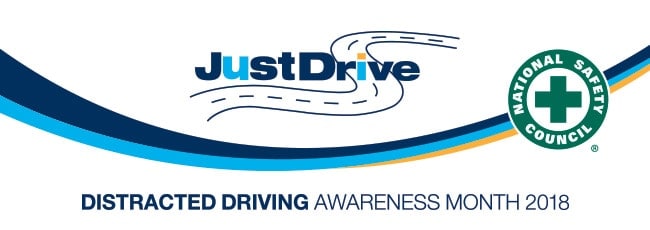
09 Apr Just Drive! 4 Steps to Distraction-Free Driving
Distracted Driving Awareness Month, – April 2018
April is Distracted Driving Awareness Month. According to the National Safety Council,
Distracted driving is a public health issue that affects us all. The latest statistics show motor vehicle fatalities are up 6% from 2015. More than 40,000 people were killed on our nation’s roadways last year, and distracted driving is a major contributor.
Each death is 100% preventable. From cell phones to dashboard infotainment systems to evolving voice command features – all pose a threat to our safety. Just one second of your attention is all takes to change a life forever.
Distracted Driving Awareness Month in April is a united effort to recognize and eliminate preventable deaths from distracted driving. Join us to help save lives.
Distracted Driving is an Epidemic
I think all of us have been guilty of this at least once. Sadly, it seems like 9 out of 10 people we see on the road are looking at a phone while driving. This is not acceptable. It’s terrifying to think of the risks we take every day on the road.
And almost as frightening is the fact that most of us do it without thinking about it. We are so habit-driven that we just flow on instinct. The phone rings or dings or buzzes, and we just answer. It’s like we forget we’re driving at all.
Distracted Driving is a Habit
The reflex to answer is a habit that developed naturally. But we have to change it on purpose. We all know we need to. We all know how important it is. And we all know that the lives of our families, other people, and ourselves depend on changing these habits.
But how do we change those bad habits? Is it enough to just say to ourselves, “I’m not going to text and drive.”? Probably not.
We have an action plan for you. But first, think through what it really means to drive “un-distracted.” Here’s a really excellent checklist published by the National Safety Council. In many ways, it is an action plan in itself.
What is Distraction-free Driving?

- First and foremost, turn off your cell phone. Put it in the glove compartment, in your purse or in your trunk. There is no safe way to make a call while driving – not even hands-free.
- Send and read text messages and emails before you start driving.
- If you’re going on a long drive, schedule breaks to stop, park safely, and respond to messages.
- Using voice features in your car’s infotainment system is also distracting. Take care of communications before you start driving.
- Know where you’re going before you put the car in “drive.” Put your destination into your GPS so you do not need to touch it while the car is moving.
- Social media can wait. No update, tweet or video is worth a life.
- Park in a safe area if you must take a call, return a text or check email.
- Do not call or text friends or family if you know they are driving
I think that’s a great checklist from the NSC. They’ve also given us a couple of important things to think about this month.
Multi-tasking is a myth
First, that multi-tasking is a myth. Scientists agree that no one can actually pay attention to two things at once. It’s just not a real thing. Some people are a little better at going back and forth between things. But no one is immune to distraction. So let’s get real. Distractions are distractions for everyone, not just everyone else.
Hands-free is not risk-free
Then they remind us that “hands-free is not risk-free.” As indicated in the list above, they’re including Bluetooth functionality in their list of dangerously distracting activities. It’s not just texting that is causing the problem.
Distraction-free Driving Action Plan
Now here are our keys to making the changes you need to make to drive distraction-free. These four steps are an action plan for changing the bad habits so many of us have developed. We believe that if you’ll implement this plan and stick with it, you’ll be safer. And your safety is very important to us!
1. Set Goals for Yourself.
Don’t just say “never again,” though that’s a good start. Determine to drive distraction-free for the next week. Then for the next two, the next three, and so on. Make it a habit, and stay with it.
2. Remind Yourself.
Put a note inside your car to remind you to avoid distracted driving. Or post the NSC’s checklist on your dash. Then, turn on your phone’s “Do Not Disturb While Driving” function. Your phone probably was set to that when you got it. Did you turn it off for some “emergency” like many of us have? Turn it back on! Go ahead…we’ll wait…OK, good!
3. Keep Tabs on Yourself.
Put a notepad and pen in your car. Or start a note on your phone. At the end of every trip, or at the end of every day, write down how you did. How many times did you answer a call? Did you find yourself reading texts or notifications? Take steps to correct these habits.
4. Keep Tabs on Each Other.
You can’t do this alone. And neither can the rest of us. So let’s work together. Make a driving safety pact with your family. Join with friends and make a commitment to distraction-free driving. Start a facebook group. Do anything you have to do to get some accountability. Know that this is a life and death situation, and it’s worth the effort. You’ll be glad you did.
At Truskett Law, we are a personal injury law firm. But we are also a safety law firm. We want all of you to stay safe on the roads out there. We care about you and your family.
If you have been injured in a crash, please call the Truskett Law Firm in Tulsa, Oklahoma at (918) 392-5444 today! Don’t wait! Your call and your consultation are always free and confidential.
Photo by Samuele Errico Piccarini on Unsplash


Sorry, the comment form is closed at this time.